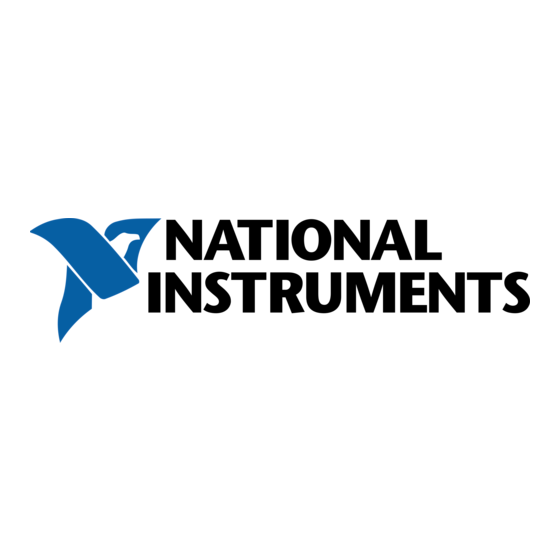Summary of Contents for National Instruments NI-9232
- Page 1 NI-9232 Getting Started Tél. 01 47 95 99 71 e-mail : ni@es-france.com ES France - Département NI Fax. 01 47 01 16 22 Site Web : www.es-france.com 127 rue de Buzenval BP 26 - 92380 Garches...
-
Page 2: Table Of Contents
NI-9232 Getting Started NI-9232 Getting Started 3-Channel, 102.4 kS/s/channel, ±30 V, C Series Sound and Vibration Input Module Contents NI-9232 Overview ......... -
Page 3: Ni-9232 Overview
NI-9232 Getting Started NI-9232 Overview In this article, the NI-9232 with screw terminal, NI-9232 with snap in terminal, and NI-9232 with BNC are referred to inclusively as the NI-9232. The information in this document applies to all versions of the NI-9232 unless otherwise specified. -
Page 4: Passband
The digital filters of the NI-9232 adjust the frequency range of the passband to match the data rate. Therefore, the amount of gain or attenuation at a given frequency depends on the data rate. -
Page 5: Data Rates With The Internal Master Timebase
NI-9232 Getting Started The following equation provides the available data rates of the NI-9232: 2 × m × n where is the data rate is the master timebase m is the decimation rate n is the clock divider from 1 to 26 There are multiple combinations of clock divider and decimation rate that yield the same data rate. - Page 6 NI-9232 Getting Started Table 1 : Available Data Rates with the Internal Master Timebase (Continued) Decimation Rate Clock Divider (kS/s) 7.31 6.83 6.40 6.02 5.69 5.39 5.12 4.88 4.65 4.45 4.27 4.10 3.94 3.66 3.41 3.20 3.01 2.84 2.69 2.56 2.44...
-
Page 7: External Master Timebase
When using an external timebase with a frequency other than 13.1072 MHz, the NI-9232 has a different set of data rates. Refer to the software help for information about configuring the master timebase source for the NI-9232. -
Page 8: Connecting Signal Sources
If you make a ground-referenced connection between the signal source and the NI-9232, make sure the voltage on the AI+ and the AI- connections are in the channel-to-earth safety voltage range to ensure proper operation of the NI-9232. Refer to the module specifications ni.com/docs for more information about operating voltages and overvoltage protection. -
Page 9: Integrated Electronic Piezoelectric (Iepe) Sensors
NOTE You must use 2-wire ferrules to create a secure connection when connecting more than one wire to a single terminal on the NI-9232 with screw terminal and NI-9232 with snap in terminal. Each channel has a terminal to which you can connect a signal source. The AI+ terminal of the connector provides the DC excitation, when enabled, and the positive input signal connection. -
Page 10: Wiring For High-Vibration Applications
If your application is subject to high vibration, NI recommends that you use the NI 9971 backshell kit to protect connections to the NI-9232 with screw terminals or NI 9990 backshell kit to protect connections to the NI-9232 with snap in terminals. - Page 11 For patents covering NI products/technology, refer to the appropriate location: Help»Patents in your software, the patents.txt file on your media, or the National Instruments Patent Notice at ni.com/patents. You can find information about end-user license agreements (EULAs) and third-party legal notices in the readme file for your NI product. Refer to the Export Compliance Information at ni.com/legal/export-compliance for the NI global trade compliance policy and how to obtain relevant HTS codes, ECCNs, and other import/export data.











Need help?
Do you have a question about the NI-9232 and is the answer not in the manual?
Questions and answers